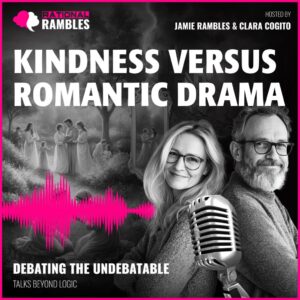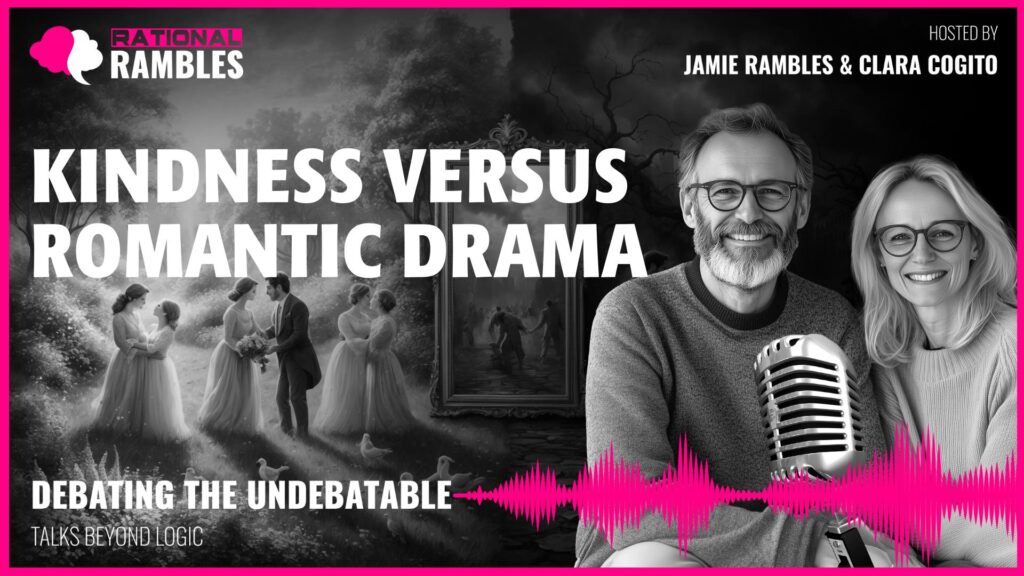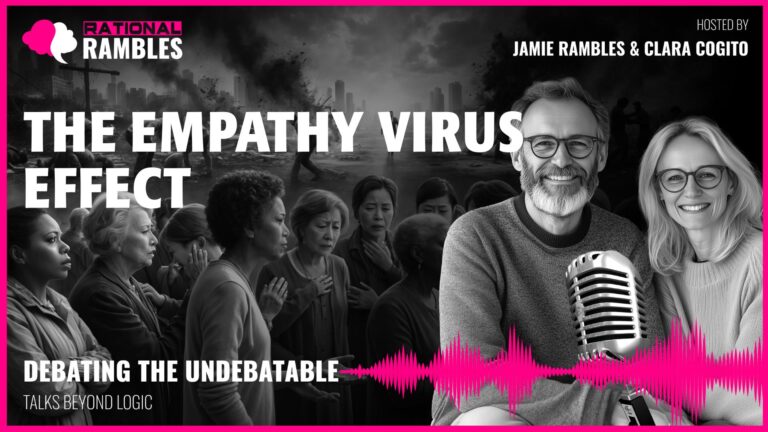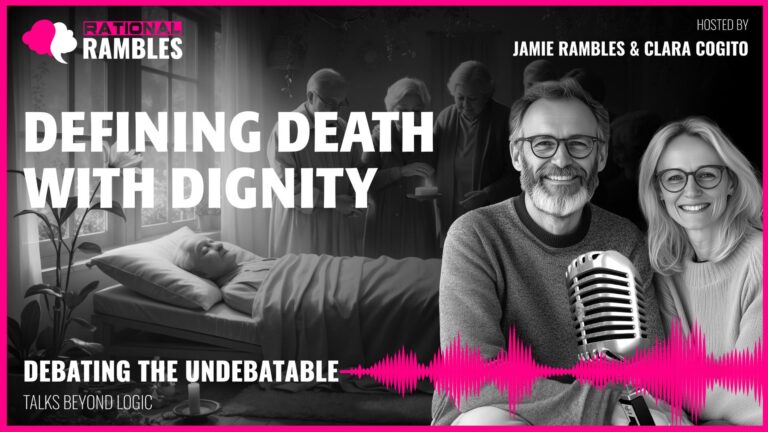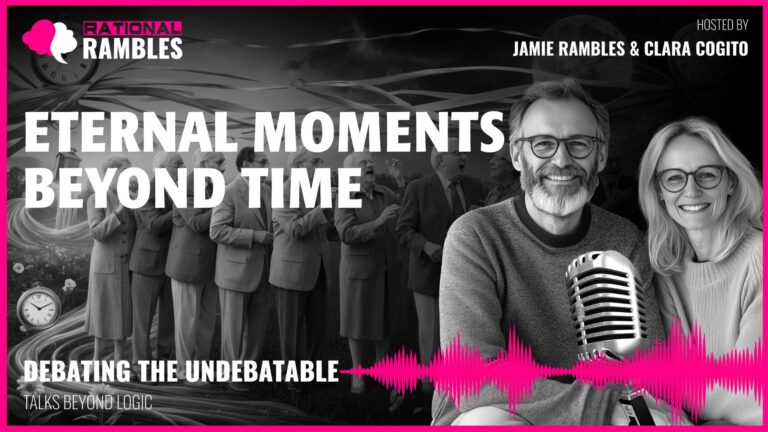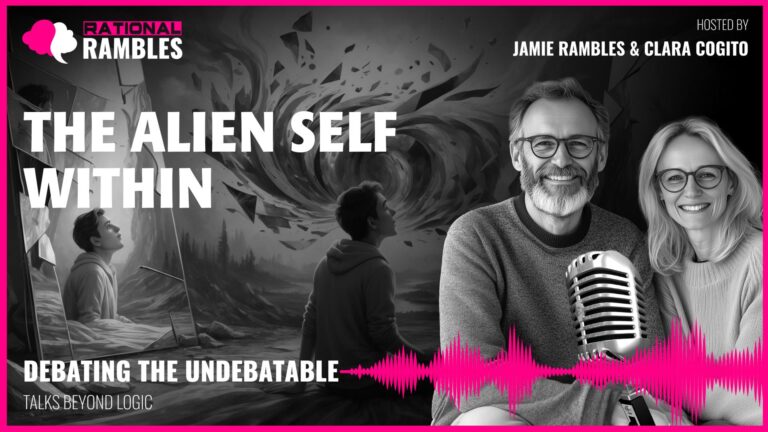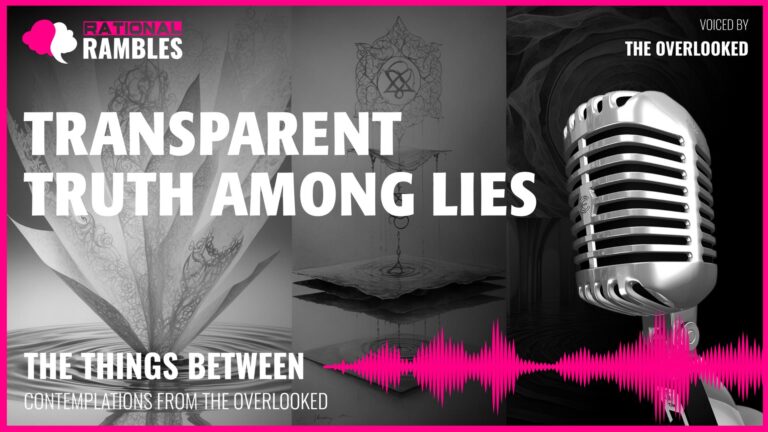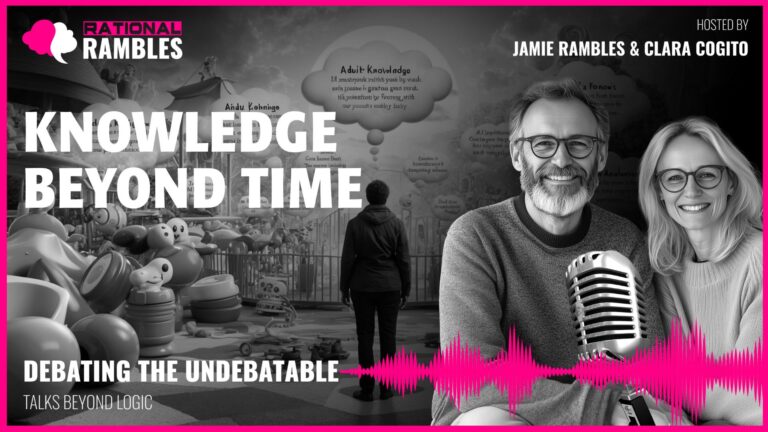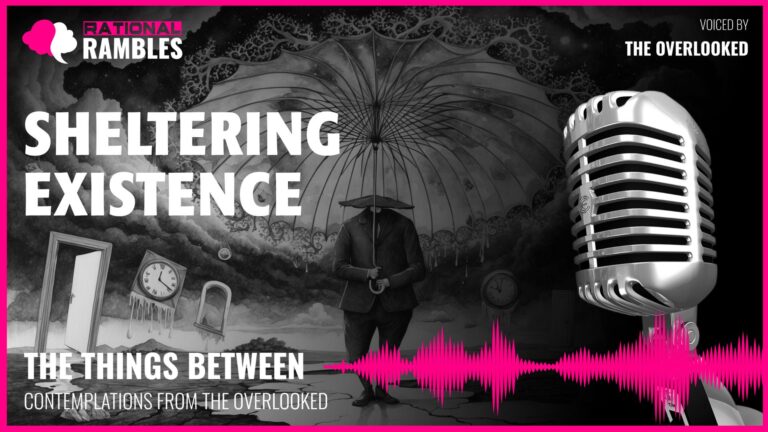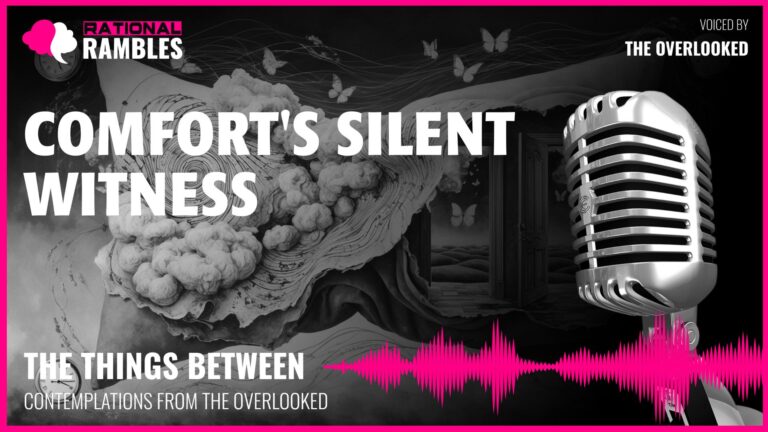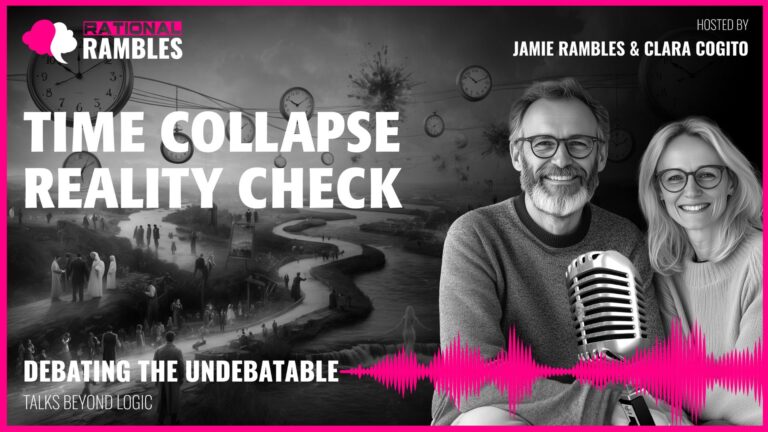The Quiet Revolution: Understanding Kindness as the Foundation of Authentic Love
Introduction: Beyond the Romantic Myth
In a culture saturated with dramatic portrayals of romance—where passionate arguments, jealous confrontations, and emotional rollercoasters are presented as evidence of deep love—a deceptively simple question emerges with revolutionary potential: “Is the person I claim to love actually kind to me?” This question, posed by philosopher Alain de Botton, cuts through layers of romantic mythology to expose a fundamental truth about human connection that many of us have been conditioned to overlook.
Our collective narrative about love often glorifies intensity and drama while relegating kindness to a secondary virtue—something nice but perhaps boring, a quality we might settle for rather than aspire to. This cultural confusion between the aesthetics of romance (what makes a compelling story) and the ethics of love (what makes a nurturing relationship) has profound consequences for our emotional lives and relational choices.
This exploration examines why we so frequently mistake drama for depth, intensity for intimacy, and chaotic connection for passionate love. Drawing on insights from attachment theory, trauma psychology, neuroscience, and philosophical traditions, we’ll investigate how our earliest experiences shape our relationship blueprints, why many people find themselves rejecting kindness in favor of familiar pain, and how consistent kindness—far from being a meek or sentimental virtue—represents a radical and transformative force in human connection.
The Neurological Basis of Romantic Irrationality
To understand why so many people find themselves drawn to tumultuous relationships while avoiding healthier connections, we must first explore how the brain becomes wired to interpret certain relational patterns as “love.” From a neurobiological perspective, our earliest attachment experiences create templates that shape how we perceive and respond to intimacy throughout our lives.
Attachment Patterns and Romantic Attraction
Attachment theory, pioneered by John Bowlby and expanded by researchers like Mary Ainsworth and Mary Main, reveals how our earliest relationships—particularly with primary caregivers—create internal “working models” of what relationships are supposed to feel like. When these early experiences feature inconsistency, emotional unavailability, or outright rejection, the developing brain adapts by forming neural pathways that associate uncertainty or even mistreatment with connection.
For someone with an anxious attachment style, the adrenaline rush of pursuing an emotionally unavailable partner can feel more like “real love” than the steady presence of someone consistently kind. For those with avoidant attachment patterns, partners who respect boundaries and offer emotional safety might trigger unconscious anxiety precisely because they don’t activate familiar fight-or-flight responses.
Research in interpersonal neurobiology demonstrates that these attachment patterns aren’t merely psychological preferences but become encoded in our neurological functioning. The brain literally becomes conditioned to equate the neurochemical cocktail of anxiety, intermittent reward, and hypervigilance with romantic connection. This explains the common phenomenon where someone might intellectually recognize that a relationship is harmful while feeling emotionally unable to leave—their rational assessment is overridden by powerful neurological associations.
The Chemistry of Chaos
From a neurochemical perspective, tumultuous relationships offer a particularly potent neurological experience. The unpredictability of a partner who alternates between warmth and coldness, presence and absence, or praise and criticism creates what psychologists call an “intermittent reinforcement schedule”—the same mechanism that makes gambling addictive. When rewards are unpredictable, the brain produces higher levels of dopamine in anticipation, creating a stronger sense of craving and attachment than consistent positive treatment would generate.
Additionally, the heightened emotional states of conflict and reconciliation trigger releases of stress hormones followed by bonding chemicals like oxytocin during moments of reunion. This biochemical rollercoaster can create a powerful addiction to the cycle of tension and relief that characterizes dramatic relationships. The brain begins to associate these intense fluctuations with passion and depth, while more stable emotional states might register as lacking something essential.
This neurological conditioning helps explain what philosophers might call “erotic irrationality”—the tendency to pursue what harms us while avoiding what might heal us. It’s not merely a matter of poor judgment but of deeply ingrained neurobiological patterns that equate certain harmful dynamics with the very essence of love itself.
Cultural Narratives and Emotional Scripts
While our individual attachment histories certainly influence our romantic choices, these personal patterns exist within a broader cultural context that powerfully shapes our understanding of love. Our collective storytelling—through film, literature, music, and other media—has created dominant narratives about romance that often privilege drama over kindness and intensity over consistency.
The Commercial Appeal of Romantic Drama
From a commercial standpoint, the economics of narrative strongly favor dramatic portrayals of love. Stories of smooth-functioning, kind relationships simply don’t create the same tension, emotional investment, or narrative arc that drives entertainment consumption. The “will they, won’t they” uncertainty of tumultuous relationships, the obstacles that must be overcome, the passionate arguments followed by equally passionate reconciliations—these elements keep audiences engaged and returning for more.
Hollywood films rarely end with the establishment of a healthy relationship; they typically conclude at the moment of initial union, reinforcing the idea that the exciting part of love is the chase rather than the daily practice of care and kindness. Similarly, pop songs rarely celebrate the quiet comfort of being treated well; they more frequently romanticize jealousy, obsession, or the pain of turbulent attachments.
These narratives serve as collective fantasies, allowing us to experience the neurochemical highs of romantic intensity without the actual costs. They provide a form of emotional simulation that can be compelling and cathartic. The problem arises when we mistake these stories for relationship maps, using them as guides for our own romantic lives rather than recognizing their nature as entertainment.
The Culturally Constructed Romantic Ideal
Over time, these commercial narratives have helped construct a culturally specific romantic ideal that emphasizes certain qualities while devaluing others. Passion is portrayed as inherently volatile; stability is coded as boring; jealousy becomes evidence of love’s depth; and the willingness to endure mistreatment is framed as romantic devotion rather than poor boundaries.
Research by anthropologists and cross-cultural psychologists reveals that these associations are far from universal human truths. Different cultures and historical periods have constructed radically different ideals of romantic love. What contemporary Western culture codes as “passionate” would be considered immature or dysfunctional in some cultural contexts where mature love is expected to provide stability and social harmony.
These cultural narratives become internalized as what psychologists call “emotional scripts”—mental models that tell us what love should feel like and how relationships should progress. When our actual experiences diverge from these scripts, we often question the authenticity of the connection rather than the validity of the script itself. This helps explain why someone might reject a kind, attentive partner as “boring” or worry that the absence of drama indicates a lack of passion.
These scripts are particularly powerful because they operate largely outside conscious awareness. We don’t choose them deliberately; we absorb them through thousands of cultural exposures, gradually developing implicit beliefs about love that feel self-evident rather than constructed. Recognizing the influence of these narratives is an essential step toward developing more conscious, intentional approaches to romantic connection.
Trauma Reenactment and the Paradox of Familiar Pain
One of the most powerful psychological forces in human relating is what clinicians call “trauma reenactment”—the unconscious tendency to recreate patterns from our past, particularly those involving relational wounds or developmental deficits. This mechanism helps explain one of the most puzzling aspects of romantic behavior: why people often reject kindness in favor of familiar pain.
The Compulsion to Repeat
First identified by Freud and elaborated by subsequent psychoanalytic thinkers, the “repetition compulsion” describes the mind’s tendency to revisit traumatic scenarios in an attempt to master what once overwhelmed us. When applied to relationships, this concept helps explain why someone might consistently choose partners who remind them of a neglectful parent or abusive ex-partner. It’s not a conscious choice to suffer but rather the psyche’s attempt to rewrite history—to create a different outcome in a familiar scenario.
As one trauma specialist explains: “The unconscious hope is that this time, with this person who resembles the original attachment figure, the story can have a different ending. If I can make someone who reminds me of my critical mother finally approve of me, or someone like my abandoning father finally stay, I can retroactively heal the original wound.”
This explains the magnetic pull many people feel toward partners who activate their deepest insecurities or recreate specific dynamics from childhood. The familiarity of these patterns—even when painful—provides a kind of psychic coherence that novel, healthier dynamics cannot initially match. The brain recognizes the pattern and thinks, “This is what love is supposed to feel like,” even when that feeling involves anxiety, insecurity, or mistreatment.
Identity Coherence and the Threat of Kindness
Perhaps most counterintuitively, genuine kindness and consistent acceptance can actually threaten one’s sense of identity when they contradict core beliefs formed through earlier relationships. If someone grew up believing they were fundamentally unworthy of love, or that love must be earned through performance and self-sacrifice, being treated with unconditional positive regard creates cognitive dissonance. The kind treatment contradicts their internal narrative about who they are and what they deserve.
In trauma psychology, this phenomenon connects to what’s called “identity coherence”—the need to maintain a stable sense of self, even when that sense of self includes negative beliefs. Someone who has integrated “I am unlovable” or “I must earn care through suffering” into their core identity may unconsciously sabotage healthy relationships because accepting genuine kindness would require a profound—and therefore threatening—restructuring of their self-concept.
This explains why some people report feeling like they’re “disappearing” or “losing themselves” when treated with consistent kindness by a partner. Without the familiar struggle to earn love or the hypervigilance required in unpredictable relationships, they lose access to the relational strategies that have defined their approach to connection throughout their lives.
Therapists who work with survivors of chronic childhood trauma often observe this paradox: the client consciously seeks healthy love but unconsciously feels terrorized by it when it appears. What would seem to be the solution becomes, instead, a new problem to overcome—learning to tolerate being treated well despite every instinct to return to familiar suffering.
The Ethics of Kindness in Love
While psychological factors help explain our attraction to unkind relationships, ethical dimensions emerge when we consider what love ought to be. Philosophical traditions across cultures and throughout history have grappled with the moral dimensions of interpersonal love, often arriving at conclusions that prioritize care, respect, and benevolence toward the beloved.
Kindness as Wishing Well for the Other
Aristotle’s concept of philia—one of his three forms of love—involves wishing the good for another person for their own sake, not for what they provide or as an extension of oneself. This wishing well is not merely a sentiment but manifests in actions that nurture the other’s flourishing as an independent being.
Similarly, in Buddhist traditions, metta (loving-kindness) represents an attitude of benevolence and active care toward others that is unconditioned by their ability to benefit the self. The Dalai Lama defines love as “wanting others to be happy,” a simple yet profound reframing that centers the wellbeing of the beloved rather than the gratification of the lover.
These conceptions of love stand in stark contrast to models that position romantic relationships as sites of power struggle, need fulfillment, or ego validation. They suggest that kindness—actively supporting another’s wellbeing and honoring their autonomy—is not merely a nice feature of love but constitutes its ethical core.
The Distinction Between Having and Being
Erich Fromm’s distinction between “having” and “being” modes of existence offers a useful framework for understanding different approaches to love. In the “having” mode, relationships become about what another person can provide—status, validation, sexual gratification, emotional support, or relief from loneliness. The person becomes secondary to their function in the lover’s life.
In the “being” mode, by contrast, we relate to others in their wholeness and complexity, seeing them not as extensions of ourselves or as need-fulfillment mechanisms but as autonomous subjects with their own intrinsic worth. Kindness flows naturally from this orientation because we’re responding to a person, not a projection or object of utility.
Martin Buber’s distinction between “I-It” and “I-Thou” relationships parallels this concept. In I-It relationships, we experience others as objects to be used or managed; in I-Thou relationships, we encounter them as subjects to be known and respected in their alterity or otherness. Kindness requires this I-Thou orientation—the recognition of the beloved as an end in themselves rather than a means to our own ends.
Love as Recognition
Perhaps the most profound ethical dimension of kindness in love involves what philosophers like Axel Honneth and Charles Taylor call “recognition”—the affirmation of another’s full personhood, dignity, and agency. True kindness in love goes beyond mere pleasantness or conflict avoidance to actively affirm the beloved’s intrinsic worth and right to self-determination.
This concept of recognition helps distinguish authentic kindness from its counterfeits. Paternalistic or controlling behaviors might present as “caring” while actually undermining the other’s autonomy. Superficial niceness might mask an unwillingness to engage authentically with conflict or difference. Genuine kindness respects the other’s boundaries, honors their subjective experience, and supports their growth even when that growth creates challenges for the relationship.
From this perspective, kindness emerges not as a secondary virtue but as the practical manifestation of ethical love—the daily practice of recognizing another’s humanity and acting in accordance with that recognition. A relationship without this fundamental kindness may involve attachment, desire, or dependency, but it lacks the ethical dimension that distinguishes authentic love from its many imitations.
The Psychology of Relational Discernment
If consistent kindness forms the ethical foundation of healthy love, how do we develop the capacity to recognize and value it in our relationships? This question points toward what might be called “relational discernment”—the ability to distinguish between authentic care and its many counterfeits, between partners who support our flourishing and those who undermine it.
Mentalization and the Recognition of Otherness
Central to relational discernment is the psychological capacity for mentalization or “reflective functioning”—the ability to perceive others as having separate minds with their own valid subjective experiences. This capacity, which develops optimally in secure attachment relationships, allows us to recognize others as distinct beings rather than as extensions of ourselves or objects that exist to fulfill our needs.
Without adequate mentalization, relationships become battlegrounds where we fight against projections rather than relating to actual people. We may attribute malicious intent to a partner’s neutral actions, misinterpret their emotions based on our own fears, or fail to recognize how our behavior impacts them. This distorted perception makes genuine kindness both difficult to offer and to recognize when offered to us.
The philosophical parallel to mentalization appears in Iris Murdoch’s concept of “unselfing”—the difficult but necessary process of seeing others as they truly are rather than as projections of our desires or fears. Murdoch argues that love requires this clear vision, this willingness to encounter the reality of another person beyond our preconceptions or self-interest.
Developing stronger mentalization involves cultivating curiosity about others’ internal experiences, practicing perspective-taking, and becoming aware of our tendency to project our own fears and desires onto those around us. As this capacity strengthens, we become better able to distinguish between partners who relate to us as autonomous beings worthy of care and those who relate to us as need-fulfillment mechanisms or extensions of themselves.
Object Constancy and Relational Stability
Another crucial aspect of relational discernment involves what psychologists call “object constancy”—the ability to maintain a stable, positive connection to someone even when they disappoint us or when we’re separated from them. Without this capacity, relationships become rollercoasters of idealization and devaluation, where a partner is experienced as all good when meeting our needs and all bad when failing to do so.
Object constancy allows us to hold a more integrated view of others that accommodates both their strengths and limitations. It enables us to experience frustration or conflict without questioning the fundamental goodness of the relationship. This capacity serves as an internal stabilizer, preventing the dramatic swings between adoration and contempt that characterize many chaotic relationships.
The philosophical parallel appears in what Aristotle might call moderation or temperance in love—avoiding both excessive idealization and excessive criticism of the beloved. This moderation doesn’t mean settling for mediocre relationships but rather developing a more realistic and sustainable appreciation for others that acknowledges their humanity rather than demanding perfection.
As object constancy develops, we become more capable of recognizing and valuing consistent kindness rather than being seduced by the dramatic highs and lows of tumultuous relationships. We can tolerate the ordinariness of day-to-day care without feeling that “something is missing” from the relationship.
Corrective Emotional Experiences
For those who have known primarily chaotic or unkind relationships, developing relational discernment often requires what therapists call “corrective emotional experiences”—new relational encounters that contradict previously established patterns and expectations. These experiences might occur in therapy, friendship, mentorship, or romantic relationships that depart from familiar but destructive patterns.
Through these new experiences, the nervous system gradually recalibrates, developing new reference points for what love feels like. The person begins to recognize that the absence of drama doesn’t indicate a lack of passion but rather creates space for deeper connection. They develop new associations between safety and intimacy rather than equating love with hypervigilance or emotional extremes.
This process rarely occurs as a single epiphany but rather as a series of small realizations that accumulate over time: the surprise of being heard rather than dismissed during a vulnerable disclosure; the novel experience of having boundaries respected rather than challenged; the unfamiliar relief of being with someone whose words and actions align consistently.
Each of these experiences creates tiny fissures in previously rigid beliefs about relationships, gradually opening space for new possibilities. Over time, what once felt uncomfortable or suspicious—being treated with consistent kindness—begins to feel not only acceptable but necessary for genuine connection.
The Transformation of Relational Patterns
For those caught in cycles of unkind relationships, the possibility of transformation often seems both desperately desired and frustratingly elusive. What allows someone to break these patterns and develop both the capacity to choose kinder partners and to offer more consistent kindness themselves?
Awareness and Pattern Recognition
The first step in transformation typically involves developing awareness of patterns that have previously operated outside conscious recognition. This might mean noticing that what seemed like unique attractions to particular individuals actually follow a predictable template—perhaps consistently choosing partners who are emotionally unavailable, critical, or who require caretaking at the expense of one’s own needs.
This pattern recognition often emerges through painful repetition—experiencing the same relationship dynamics with different partners until the common elements become impossible to ignore. Sometimes it develops through therapy, where a skilled clinician helps identify recurrent themes across relationships. Other times it comes through conversations with trusted friends who can offer external perspective on choices that feel internally compelling but lead to consistent suffering.
Whatever the pathway, this growing awareness creates critical distance from patterns that have previously felt like fate or chemistry. It allows for the crucial recognition that what feels like inevitable attraction may actually be a learned response that can be unlearned with conscious effort.
Connecting Patterns to Origins
As awareness develops, the next phase often involves connecting these patterns to their developmental origins—understanding how early experiences with caregivers or significant relationships shaped one’s relationship blueprint. This doesn’t mean simplistically blaming parents for adult relationship difficulties but rather recognizing how adaptive responses to childhood circumstances may have become maladaptive in adult relationships.
For example, someone might recognize that their attraction to emotionally unavailable partners recreates the dynamic with a distant parent, with the unconscious hope that this time they might earn the love and attention previously withheld. Or they might see how growing up with unpredictable caregivers trained them to equate hypervigilance and emotional intensity with love, making stable relationships feel uncomfortably foreign.
This developmental understanding helps transform self-judgment into self-compassion. Rather than seeing oneself as defective for making harmful relationship choices, one can recognize these patterns as understandable adaptations to early experiences—strategies that once served important protective functions but now limit access to healthier connections.
Grieving and Processing
Perhaps the most challenging aspect of transformation involves grieving what wasn’t received in formative relationships and processing accumulated relational trauma. This grief work acknowledges the genuine losses and pain experienced both in childhood and in subsequent adult relationships that reenacted early patterns.
This process often involves moving through difficult emotions that have previously been avoided through relationship drama or other distractions: anger at those who failed to provide needed care; sadness about opportunities and time lost to harmful relationships; fear about surviving without familiar coping strategies; and grief for the self that developed around these wounds.
Trauma processing allows these experiences to be metabolized and integrated rather than unconsciously reenacted. Through therapy, support groups, journaling, or other reflective practices, one gradually develops the capacity to hold these painful experiences as part of one’s story without being defined or driven by them.
Practicing New Ways of Relating
The final phase of transformation involves deliberately practicing new ways of relating—both to oneself and others—that gradually establish new neural pathways. This practice begins with self-relationship, developing greater self-compassion and clearer boundaries. It extends to friendships and other connections where new relational skills can be developed in contexts that may feel safer than romantic relationships.
In romantic contexts, this practice might involve consciously choosing partners who exhibit kindness and emotional availability, even when they don’t trigger the familiar chemistry of chaotic connections. It means staying present with the discomfort that healthier dynamics might initially create rather than retreating to more familiar but harmful patterns.
It also involves developing one’s own capacity for kindness—learning to respond to others from a place of genuine care rather than self-protection or need-fulfillment. This requires cultivating greater emotional regulation, clearer communication, and the willingness to be vulnerable in appropriate contexts rather than armored against potential hurt.
This transformation rarely proceeds in a linear fashion. There are typically setbacks, periods of regression to familiar patterns, and moments of doubt about whether change is truly possible. Yet over time, with persistence and support, new patterns can become not only possible but more comfortable and rewarding than the old ones they replace.
Kindness as Revolutionary Practice
Far from representing a merely sentimental or conventional virtue, consistent kindness in relationships emerges as something quite radical—even revolutionary—in a cultural context that often celebrates dominance, strategic withholding, or what might be called “emotional game-playing” in relationships. To practice genuine kindness in such a context requires a certain courage and willingness to challenge prevailing norms.
Beyond Power Dynamics
When relationships become defined by power struggles—by who needs whom less, who has the upper hand, who can control the other’s emotional state—kindness represents a radical alternative. It suggests the possibility of connection based not on dominance and submission but on mutual recognition and care.
This perspective challenges the common belief that “love is always a power struggle” or that romantic relationships necessarily involve strategic advantage-seeking. It suggests instead that authentic love involves transcending these power dynamics in favor of a mutual commitment to supporting each other’s wellbeing and autonomy.
From an evolutionary perspective, this transcendence requires overriding certain self-protective instincts in service of connection. While our neurobiological inheritance includes competitive and dominance-seeking tendencies, it also includes capacities for empathy, cooperation, and care that can be consciously cultivated through practice and intention.
Vulnerability as Strength
Central to the revolutionary potential of kindness is a reconceptualization of vulnerability—not as weakness to be avoided but as courage to be admired. In a culture that often equates emotional invulnerability with strength, choosing to remain open and responsive even when hurt requires significant internal resources.
Genuine kindness means remaining emotionally accessible rather than armored, willing to be affected by another’s experience rather than maintaining rigid self-protection. It means acknowledging interdependence rather than performing self-sufficiency. These choices run counter to dominant cultural narratives about strength and success, particularly those aimed at men but increasingly affecting people across gender identities.
Research on long-term relationship satisfaction consistently shows that this capacity for vulnerable engagement—rather than cool detachment or strategic maneuvering—predicts relationship longevity and mutual flourishing. What feels risky in the short term often creates greater security and satisfaction over time.
Resisting Cultural Messages
Practicing consistent kindness means actively resisting powerful cultural messages about romance and attraction. It means questioning the glorification of jealousy as evidence of love’s depth, challenging the equation of emotional games with sophistication, and rejecting the romanticization of suffering as necessary for authentic connection.
This resistance isn’t merely conceptual but practical—it involves making relationship choices that might initially feel counterintuitive or even boring compared to the high-drama alternatives celebrated in popular culture. It might mean choosing the responsive, emotionally available partner over the charismatically withholding one, or valuing the quiet depth of being truly known over the neurochemical highs of tumultuous passion.
Over time, this resistance creates the possibility of new cultural narratives about love—stories that celebrate the revolutionary potential of kindness rather than the familiar dramas of power and pursuit. It suggests that the most radical act in a culture of strategic relationships might be the choice to be consistently, authentically kind.
The Transformation of Self Through Kindness
Beyond its impact on individual relationships, kindness operates as a transformative practice that gradually reshapes the practitioner’s entire approach to connection. As we cultivate greater kindness—both toward ourselves and others—we develop enhanced capacities for authentic intimacy and more discerning approaches to relationship formation.
Self-Kindness as Foundation
The practice of kindness necessarily begins with one’s relationship to oneself. Self-compassion—treating oneself with the same care and consideration one would offer a good friend—creates the psychological foundation for both offering and recognizing kindness in relationships with others.
Research by psychologist Kristin Neff and others demonstrates that self-compassion correlates with healthier relationship choices, greater resilience during relationship difficulties, and clearer boundaries around mistreatment. Rather than leading to self-indulgence or narcissism as some might fear, genuine self-kindness actually enhances capacity for connection with others.
This self-kindness practice involves several components: mindful awareness of one’s emotional experience without suppression or exaggeration; recognition of one’s struggles as part of common humanity rather than evidence of personal defectiveness; and active self-soothing during moments of suffering rather than harsh self-criticism.
As this practice develops, it naturally extends outward. The person who can meet their own pain with compassion becomes more capable of responding compassionately to others’ struggles. The person who acknowledges their own worth becomes less likely to tolerate persistent unkindness from partners. The internal relationship becomes a template for external ones.
Neuroplasticity and Relational Capacity
From a neurobiological perspective, the practice of kindness—both self-directed and other-directed—actually rewires the brain over time. Research in interpersonal neurobiology demonstrates that regular compassion practices strengthen neural networks associated with empathy, emotional regulation, and secure attachment while weakening those associated with threat-detection and defensive responding.
This neuroplasticity explains how patterns that once felt inescapable can gradually shift through consistent practice. The person who once equated love with drama may develop new neural pathways that associate love with safety and care instead. The hypervigilance that once seemed necessary for relationship survival may give way to a more regulated nervous system capable of deeper rest and presence.
Importantly, this transformation doesn’t require perfect execution or linear progress. Small shifts in behavior create small changes in neurology, which then make slightly larger behavioral shifts possible, in a gradually expanding cycle of growth. Even in the context of ingrained patterns, the brain remains adaptable throughout life, capable of developing new capacities through intentional practice.
Expanding Circles of Kindness
As individual capacity for kindness develops, its impact extends beyond romantic relationships to all forms of human connection. Friendships deepen, family relationships evolve, work relationships become more collaborative, and community involvement may increase. The person becomes a node of healing connection rather than perpetuating cycles of relational harm.
This expansion represents what philosophers and spiritual traditions have long recognized as the natural progression of compassion practice—beginning with self, extending to loved ones, then to neutral persons, and eventually even to difficult people or adversaries. While complete universal compassion may remain an aspirational ideal, the gradual expansion of kind awareness creates ripple effects throughout one’s relational ecosystem.
These ripples matter not only for individual wellbeing but for collective healing. In a culture marked by increasing polarization, isolation, and instrumental approaches to human connection, each person who develops greater capacity for kindness becomes a counter-current to these trends—a living embodiment of more ethical and fulfilling ways of relating.
Conclusion: The Quiet Revolution of Consistent Kindness
We began with Alain de Botton’s deceptively simple question about love: “Is the person I claim to love actually kind to me?” What emerged through our exploration is that this question serves as both a practical compass for navigating relationships and a portal to deeper self-understanding. It invites us to examine not only our partners’ behavior but our own capacity to recognize and value kindness as the foundation of authentic connection.
The cultural confusion between the aesthetics of romance (what makes a compelling story) and the ethics of love (what nurtures human flourishing) has led many to mistake drama for depth, intensity for intimacy, and suffering for passion. This confusion, reinforced by powerful commercial narratives and often rooted in early attachment experiences, can keep us trapped in cycles of relationships that stimulate but ultimately deplete rather than nourish.
Kindness emerges not as a mere nicety but as a profound ethical and psychological foundation for authentic connection. Far from representing a compromise or settling, it constitutes the necessary ground from which genuine intimacy can grow. Without this foundation, other qualities that we might value in relationships—passion, excitement, growth, depth—become distorted or unsustainable.
The path toward valuing and embodying kindness in relationships often requires courage—the willingness to question familiar patterns, to tolerate the discomfort of new ways of relating, to remain vulnerable in a culture that often equates invulnerability with strength. It involves developing new capacities for self-compassion, clearer relational discernment, and more authentic responses to others.
This path is rarely straight or simple. It involves setbacks, moments of regression to familiar patterns, and periods of doubt about whether transformation is truly possible. Yet the evidence from both clinical experience and research suggests that with persistence and support, new patterns can become not only possible but more comfortable and rewarding than the old ones they replace.
By reclaiming kindness as a central value in love, we challenge cultural narratives that equate drama with depth and suffering with passion. We open possibilities for relationships characterized not by power struggles or traumatic reenactments but by mutual growth, genuine care, and the quiet revolution of consistent kindness—a revolution that transforms not only our intimate relationships but our entire approach to human connection.
References and Further Reading
Bowlby, J. (1988). A secure base: Parent-child attachment and healthy human development. Basic Books.
Brown, B. (2010). The gifts of imperfection: Let go of who you think you’re supposed to be and embrace who you are. Hazelden Publishing.
De Botton, A. (2016). The course of love. Hamish Hamilton.
Fisher, H. E. (2016). Anatomy of love: A natural history of mating, marriage, and why we stray. W. W. Norton & Company.
Fromm, E. (1956). The art of loving. Harper & Row.
Johnson, S. M. (2008). Hold me tight: Seven conversations for a lifetime of love. Little, Brown Spark.
Levine, A., & Heller, R. (2010). Attached: The new science of adult attachment and how it can help you find—and keep—love. Penguin.
Murdoch, I. (1970). The sovereignty of good. Routledge & Kegan Paul.
Neff, K. (2011). Self-compassion: The proven power of being kind to yourself. William Morrow.
Perel, E. (2006). Mating in captivity: Unlocking erotic intelligence. Harper.
Real, T. (2007). The new rules of marriage: What you need to know to make love work. Ballantine Books.
Siegel, D. J. (2010). Mindsight: The new science of personal transformation. Bantam.
Solomon, R. C. (1994). About love: Reinventing romance for our times. Rowman & Littlefield Publishers.
Van der Kolk, B. (2014). The body keeps the score: Brain, mind, and body in the healing of trauma. Viking.


